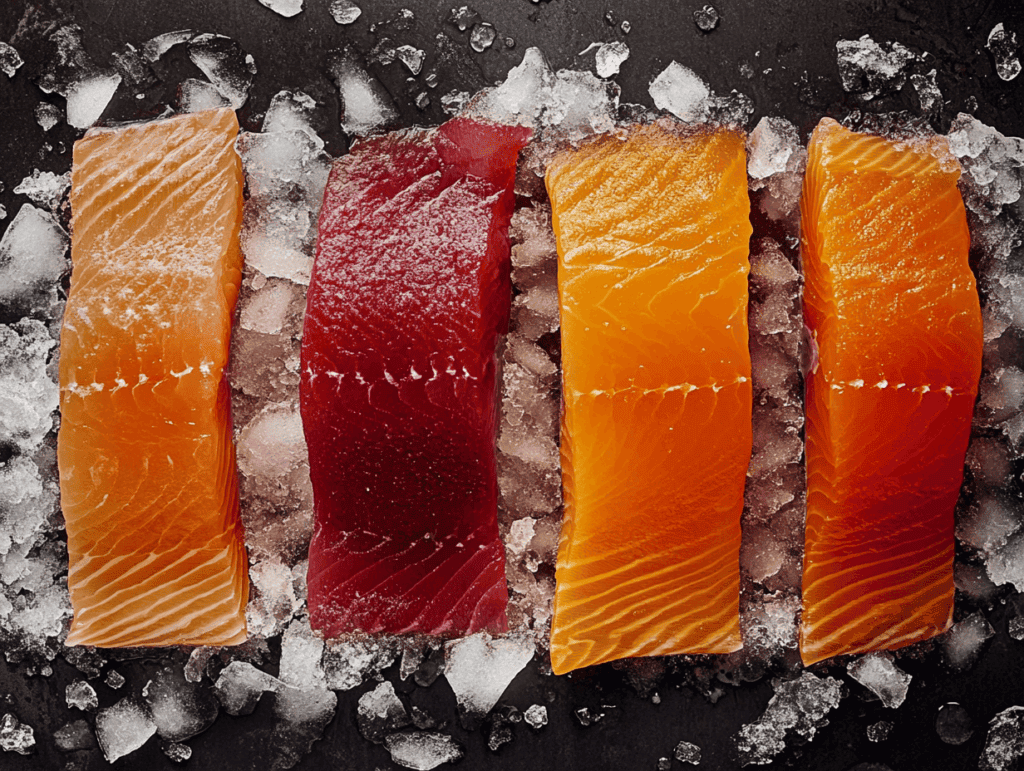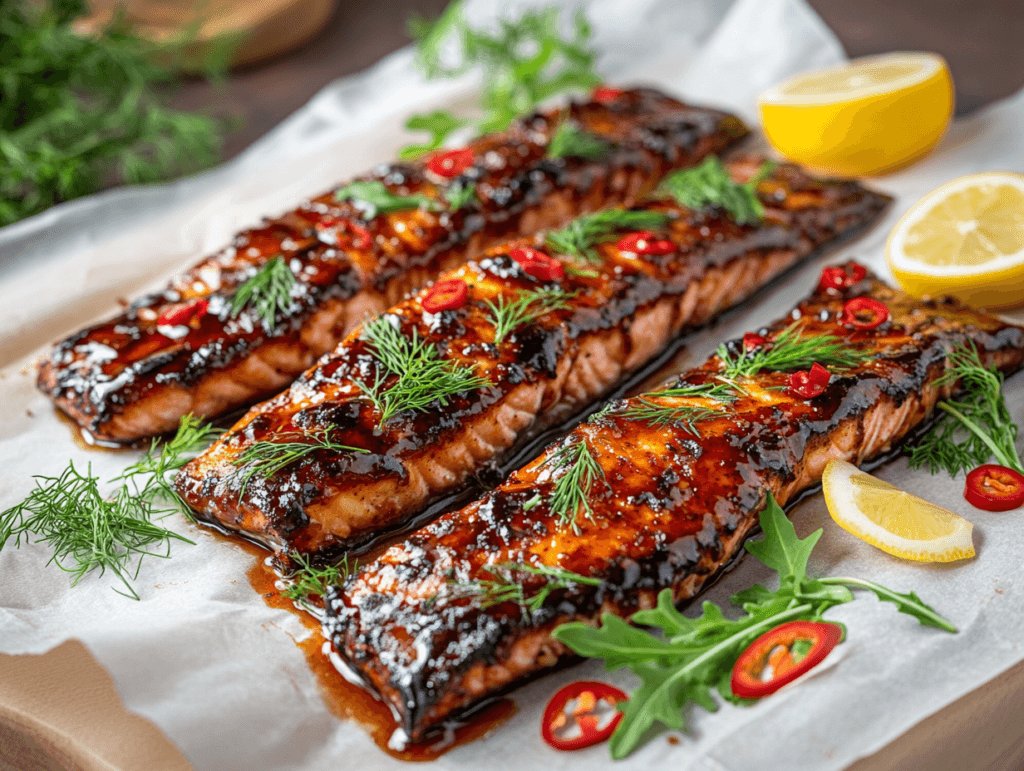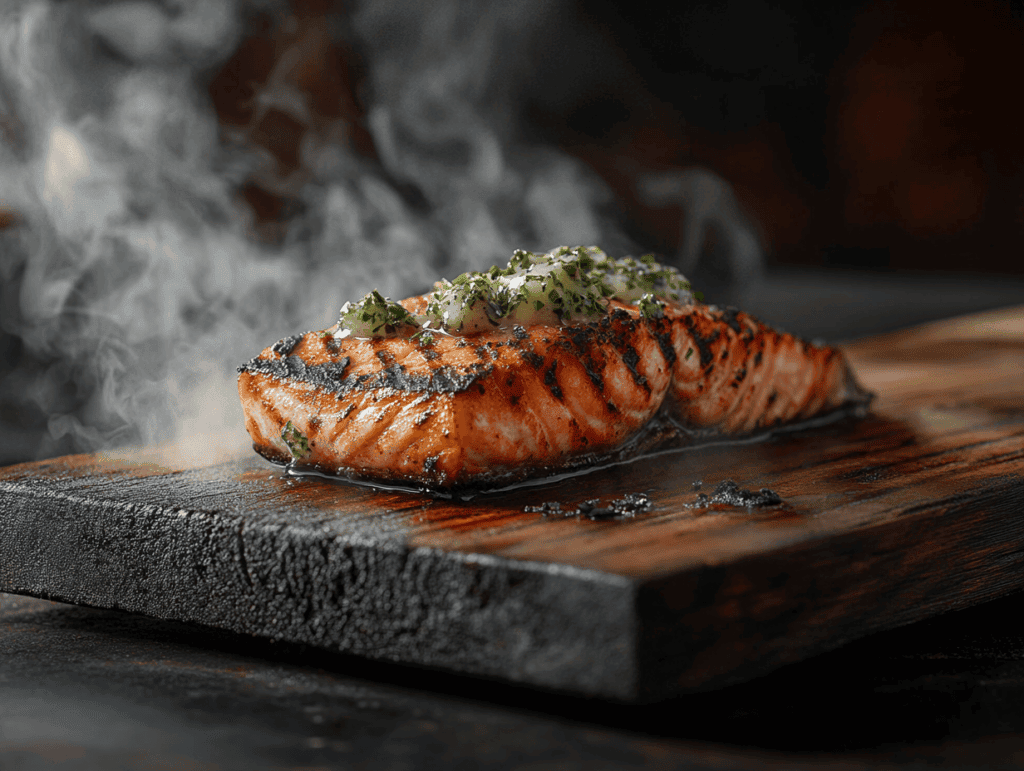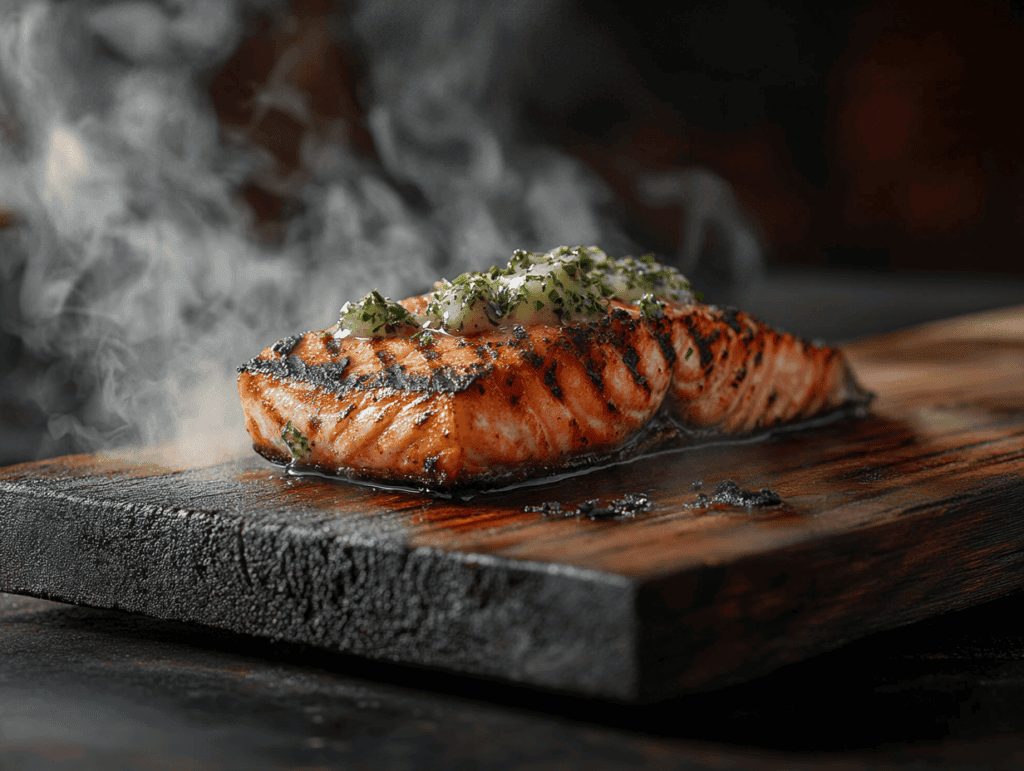Salmon is one of the most versatile, nutritious, and delicious proteins available, yet many home cooks feel intimidated by preparing it. Whether you’re concerned about overcooking this delicate fish or unsure which cooking method yields the best results, this comprehensive guide to salmon recipes will transform you into a salmon expert. We’ll explore five foolproof cooking techniques that deliver perfect results every time, complete with pro tips, flavor variations, and stunning serving suggestions that will impress family and friends alike.

Table of Contents
Why Salmon Deserves a Place in Your Regular Meal Rotation
Delicious Salmon Recipes
Explore a variety of salmon recipes that showcase the versatility of this incredible fish, perfect for any occasion.
Before diving into cooking methods, let’s appreciate why salmon is such a remarkable ingredient. This pink-fleshed fish offers an impressive nutritional profile, featuring high-quality protein, omega-3 fatty acids, vitamin D, and B vitamins. Beyond its health benefits, salmon’s rich, buttery texture and distinctive flavor make it a culinary canvas that pairs beautifully with countless seasonings and side dishes.
Salmon Recipes – Method 1: Perfectly Baked Salmon
Wild-caught salmon varieties (like sockeye, coho, and king) offer more intense flavor and color, while farm-raised Atlantic salmon provides a milder taste and more consistent availability. Both have their place in the kitchen, and the cooking methods we’ll explore work wonderfully with any variety you choose.
Method 1: Perfectly Baked Salmon

Baking is perhaps the most foolproof method for cooking salmon, offering consistent results with minimal hands-on attention. This gentle, even heat approach is perfect for beginners and busy weeknights alike.
The Technique
- Preheat your oven to 375°F (190°C) – This moderate temperature cooks salmon thoroughly without drying it out.
- Prepare your salmon – Place a 1-1.5 pound salmon fillet (or individual portions) on a parchment-lined baking sheet. Pat the surface dry with paper towels.
- Season generously – Drizzle with olive oil and season with salt, pepper, and your choice of herbs or spices. For a simple yet elegant preparation, try lemon zest, fresh dill, and a touch of garlic powder.
- Bake until just cooked through – For a standard 1-inch thick fillet, bake for 12-15 minutes. The salmon is done when it flakes easily with a fork but still maintains a slightly translucent center. For food safety, the internal temperature should reach 145°F (63°C), but many chefs prefer removing it from the oven at 135-140°F (57-60°C) as it will continue cooking slightly after removal.
Pro Tips for Baked Salmon
- Even thickness matters – If your fillet tapers at the ends, fold the thin sections underneath to create a more uniform thickness, ensuring even cooking.
- Try the foil packet method – For extra-moist salmon, create a sealed foil packet around the fish with a splash of white wine or citrus juice before baking.
- Don’t overcook – Salmon continues cooking after you remove it from the oven. When in doubt, it’s better to slightly undercook than overcook.
Flavor Variations
- Mediterranean – Top with a mixture of chopped olives, capers, cherry tomatoes, and fresh herbs before baking.
- Asian-Inspired – Brush with a mixture of soy sauce, honey, ginger, and garlic before baking.
- Herb Crusted – Press a mixture of fresh herbs, breadcrumbs, and Parmesan cheese onto the top before baking.
Method 2: Pan-Seared Salmon with Crispy Skin

For restaurant-quality salmon with irresistibly crispy skin and a perfectly tender interior, pan-searing is unmatched. This method requires a bit more attention but rewards you with exceptional texture contrast.
The Technique
- Start with room temperature salmon – Remove your salmon from the refrigerator 15-20 minutes before cooking to ensure even cooking.
- Prepare the salmon – Pat the salmon completely dry with paper towels (moisture is the enemy of crispy skin). Season the flesh side with salt and pepper.
- Heat the pan properly – Use a heavy-bottomed skillet (preferably cast iron or stainless steel) and heat it over medium-high heat until very hot. Add a high smoke-point oil like grapeseed or avocado oil.
- Cook skin-side down first – Place the salmon skin-side down in the hot pan. The key secret: don’t touch it for 4-5 minutes. This allows the skin to crisp up beautifully.
- Press down gently – Use a fish spatula or the back of a flexible spatula to gently press the fillet down for the first 10-15 seconds, ensuring full contact between skin and pan.
- Flip and finish – When the skin is crispy and the salmon has cooked about 3/4 of the way up the sides, flip it gently and cook for just 1-2 minutes more until the internal temperature reaches 130-135°F (54-57°C).
- Rest before serving – Let the salmon rest for 2-3 minutes before serving to allow juices to redistribute.
Pro Tips for Pan-Seared Salmon
- Score the skin – Making shallow cuts in the skin before cooking helps prevent curling.
- Use a splatter screen – This method can create some oil splatter, so a screen is helpful for easier cleanup.
- Don’t crowd the pan – Cook in batches if necessary; overcrowding causes steaming instead of searing.
Serving Suggestions
- Lemon-Caper Sauce – Deglaze the pan with white wine, add lemon juice and capers for a quick pan sauce.
- Herb Butter – Top with a compound butter made with fresh herbs, garlic, and lemon zest.
- Cucumber-Yogurt Relish – Serve with a cool cucumber, dill, and yogurt relish for temperature and texture contrast.
Method 3: Grilled Salmon with Perfect Char Marks

Grilling imparts a delicious smoky flavor to salmon while creating beautiful char marks. This method is perfect for summer entertaining and adds a wonderful dimension to the fish’s natural flavor.
The Technique
- Preheat your grill properly – Heat your grill to medium-high (about 375-400°F or 190-205°C). Clean and oil the grates thoroughly to prevent sticking.
- Prepare the salmon – Pat salmon fillets dry and brush both sides with oil. Season generously with salt, pepper, and any desired spices.
- Start skin-side up – Place the salmon flesh-side down (skin-side up) on the grill. This allows you to get nice grill marks on the presentation side first.
- Don’t move it too soon – Let the salmon cook undisturbed for 4-5 minutes until it releases easily from the grates.
- Flip carefully – Using a wide, thin spatula, gently flip the salmon and cook skin-side down for another 3-4 minutes until the internal temperature reaches 130-135°F (54-57°C).
- Rest before serving – Let the salmon rest for 3-5 minutes before serving.
Pro Tips for Grilled Salmon
- Use a fish basket – For easier handling, especially with smaller pieces, a fish grilling basket is invaluable.
- Cedar planks – For a distinctive smoky flavor, try grilling salmon on soaked cedar planks.
- Indirect heat method – For thicker fillets, sear over direct heat, then move to indirect heat to finish cooking gently.
Marinades and Rubs
- Brown Sugar and Spice Rub – Mix brown sugar, smoked paprika, garlic powder, and a touch of cayenne for a sweet-spicy crust.
- Citrus Herb Marinade – Combine citrus zest and juice with fresh herbs, garlic, and olive oil (marinate for no more than 30 minutes to avoid “cooking” the fish in acid).
- Teriyaki Glaze – Brush with teriyaki sauce during the last minute of grilling for a glossy, flavorful finish.
Method 4: Poached Salmon for Delicate Perfection

Poaching produces exceptionally tender, moist salmon with subtle flavor. This gentle cooking method is perfect for those who prefer a softer texture and is excellent for meal prep as the results refrigerate beautifully.
The Technique
- Choose your poaching liquid – Traditional court bouillon (water with aromatics like lemon, herbs, and vegetables) works wonderfully, but you can also use white wine, fish stock, or even olive oil for different flavor profiles.
- Prepare your poaching setup – In a large, shallow pan, add enough liquid to come halfway up the sides of your salmon fillets. Add aromatics like lemon slices, fresh herbs, peppercorns, and a bay leaf.
- Heat the liquid properly – Bring the liquid to a gentle simmer (not boiling) at about 170-180°F (77-82°C).
- Add the salmon – Gently slide the salmon into the liquid, skin-side down.
- Maintain gentle heat – Keep the liquid at a bare simmer—you should see only occasional small bubbles. Cover partially with a lid.
- Cook until just done – Depending on thickness, this takes about 8-10 minutes for a 1-inch thick fillet. The salmon should be opaque but still moist in the center.
Pro Tips for Poached Salmon
- Use a thermometer – Both for the liquid temperature and the salmon’s internal temperature (aim for 125-130°F or 52-54°C for perfectly poached salmon).
- Try cold poaching – For an advanced technique, bring the liquid to a simmer, add the salmon, turn off the heat, and let it sit covered until cooked through (about 10-15 minutes).
- Save the poaching liquid – Strain and freeze it for future use in soups or sauces.
Serving Ideas
- Chilled with Dill Sauce – Serve cold with a creamy dill and cucumber sauce for a refreshing meal.
- Salmon Salad – Flake poached salmon over mixed greens with a light vinaigrette.
- Open-Faced Sandwiches – Layer on good bread with cream cheese, capers, and thinly sliced red onion.
Method 5: Air Fryer Salmon for Quick Perfection
The air fryer has revolutionized home cooking, and it’s perfect for salmon. This method combines the speed of high-heat cooking with the consistent results of convection, producing salmon with a slightly crisp exterior and juicy interior in record time.
The Technique
- Preheat your air fryer – Set to 390°F (200°C) and allow it to preheat for 3-5 minutes.
- Prepare the salmon – Pat salmon fillets dry, brush with olive oil, and season as desired. For best results, use portions rather than a large fillet.
- Arrange in the basket – Place salmon skin-side down in the air fryer basket, ensuring pieces don’t touch for proper air circulation.
- Cook to perfection – Air fry for 7-9 minutes for 1-inch thick fillets. No need to flip! The circulating hot air cooks the salmon evenly from all sides.
- Check for doneness – The salmon should flake easily with a fork and reach an internal temperature of 130-135°F (54-57°C).
Pro Tips for Air Fryer Salmon
- Don’t overcrowd – Cook in batches if necessary to maintain proper air circulation.
- Use parchment paper liners – These make cleanup easier while still allowing air circulation.
- Watch carefully near the end – Air fryers can finish cooking very quickly, so check a minute or two before you expect it to be done.
Quick Glazes and Toppings
- Honey Mustard – Brush with a mixture of Dijon mustard and honey before air frying.
- Garlic Butter – Top with a slice of garlic herb butter during the last minute of cooking.
- Parmesan Crust – Press a thin layer of seasoned Parmesan on top before cooking for a crispy crust.
How to Tell When Salmon is Perfectly Cooked
Regardless of cooking method, knowing when salmon is done is crucial for perfect results. Here are three reliable ways to check:
- The Fork Test – Insert a fork into the thickest part and twist gently. If it flakes easily along the natural muscle fibers but still looks slightly translucent in the center, it’s perfect.
- Temperature Test – Use an instant-read thermometer in the thickest part. For medium doneness, aim for 125-130°F (52-54°C). For fully cooked but still moist, 135-140°F (57-60°C).
- Visual Check – Perfectly cooked salmon changes from translucent to opaque but should still look moist. If white proteins (albumin) are seeping out extensively, it’s likely overcooked.
Selecting the Best Salmon
The quality of your salmon significantly impacts your final dish. Here’s what to look for:
- Appearance – Look for vibrant color and moist-looking flesh. Avoid salmon with brown spots or dull coloring.
- Smell – Fresh salmon should smell clean and oceanic, never fishy or ammonia-like.
- Texture – The flesh should be firm and spring back when pressed gently.
- Sustainability – When possible, choose salmon certified by the Marine Stewardship Council (MSC) or the Aquaculture Stewardship Council (ASC).
Frequently Asked Questions About Cooking Salmon
Q: Should I remove the skin before cooking? A: In most cases, no. The skin helps hold the delicate flesh together during cooking and adds flavor. If you don’t want to eat it, it’s easier to remove after cooking.
Q: How long can I store cooked salmon? A: Properly refrigerated in an airtight container, cooked salmon stays good for 3-4 days.
Q: Can I cook salmon from frozen? A: Yes, though it’s not ideal. Add about 50% more cooking time and check the internal temperature to ensure it’s cooked through.
Q: Why does white stuff come out of my salmon when cooking? A: That’s albumin, a protein that coagulates and comes to the surface when salmon is cooked. A small amount is normal, but excessive albumin usually indicates overcooking.
Q: What’s the best way to reheat leftover salmon without drying it out? A: Gently reheat in a 275°F (135°C) oven until just warmed through, about 15 minutes. Alternatively, cold salmon is delicious in salads and sandwiches.
Perfect Side Dishes for Salmon
Complete your salmon dinner with these complementary side dishes:
- Roasted asparagus or green beans – Their slight bitterness balances salmon’s richness.
- Lemon herb rice or quinoa – Absorbs the delicious juices and complements the flavor.
- Cucumber and dill salad – Provides refreshing contrast to the rich fish.
- Roasted sweet potatoes – Offers color contrast and nutritional balance.
Conclusion
Mastering these five cooking methods opens up a world of salmon possibilities for any occasion, from quick weeknight dinners to elegant entertaining. Each technique highlights different aspects of this remarkable fish, from the crispy skin of pan-searing to the delicate texture of poaching.
Remember that high-quality salmon needs minimal embellishment—often just salt, pepper, and a squeeze of lemon are enough to let its natural flavor shine. As you become more comfortable with these methods, don’t be afraid to experiment with different seasonings, sauces, and accompaniments to make these techniques your own.
Which method will you try first? Whether you’re a salmon novice or looking to perfect your technique, these foolproof approaches guarantee delicious results every time.

The Ultimate Guide to Perfect Salmon: 5 Foolproof Cooking Methods
Ingredients
- 4 salmon fillets 6 oz each
- 2 tablespoons olive oil
- 1 teaspoon sea salt
- 1/2 teaspoon freshly ground black pepper
- 1 lemon sliced
- 2 cloves garlic minced (optional)
- 2 tablespoons fresh herbs dill, parsley, or thyme
Instructions
- Pat the salmon fillets dry with paper towels. This is essential for achieving crispy skin when pan-searing or grilling.Drizzle the salmon with olive oil and season generously with salt and pepper. Add minced garlic and fresh herbs if desired.Choose your cooking method:
- Method 1: BakingPreheat oven to 375°F (190°C).Place salmon on a parchment-lined baking sheet.Bake for 12-15 minutes until it flakes easily with a fork but still maintains a slightly translucent center
- .Method 2: Pan-SearingHeat a heavy-bottomed skillet over medium-high heat.Add oil and place salmon skin-side down.Cook undisturbed for 4-5 minutes until skin is crispy.Flip and cook 1-2 minutes more until internal temperature reaches 130-135°F (54-57°C).
- Method 3: GrillingPreheat grill to medium-high (375-400°F/190-205°C).Oil grates well.Place salmon flesh-side down and grill undisturbed for 4-5 minutes.Flip carefully and cook skin-side down for 3-4 minutes more.
- Method 4: PoachingIn a large, shallow pan, add enough liquid (water with aromatics, white wine, or fish stock) to come halfway up the sides of your salmon fillets.Bring to a gentle simmer at 170-180°F (77-82°C).Add salmon and cook covered for 8-10 minutes until just opaque
- .Method 5: Air FryingPreheat air fryer to 390°F (200°C).Place seasoned salmon skin-side down in the basket.Cook for 7-9 minutes until it flakes easily and reaches an internal temperature of 130-135°F (54-57°C).
Notes
- Salmon is perfectly cooked when it flakes easily with a fork but still looks slightly moist in the center.
- For medium doneness, aim for an internal temperature of 125-130°F (52-54°C).
- Let the salmon rest for 2-3 minutes before serving to allow juices to redistribute.
